Blogging tips should be simple, helpful, and effective. In this post, you’ll learn the top 35 tips used by the best bloggers and content marketers in the world to create amazing posts that keep readers coming back for more.
Do you currently manage or follow a blog? Take a minute to consider what it is about that blog that keeps you interested enough to repeatedly visit their website. Chances are, you’ll be able to think of many different appealing aspects and at least one or more of those will be covered in this article. Exceptional blogs know that their content is dictated by their audience, not the other way around.
Blogging provides lucrative opportunities to convert leads without directly having to sell to them. It’s a more organic way to interact with potential customers and one that presents a lower barrier to entry. Publishing blog posts is a great way to highlight the expertise, service/products, and personality of your brand. It’s also one of the best ways to enhance your search engine ranking, increase website traffic, and boost revenue. The list of benefits goes on and on.
In case you’re still not sure of the benefits of a business blog, here are a few stats that highlight their effectiveness:
- Businesses that blog receive 97% more links to their website
- 45% of marketers believe blogging is the most important part of their content strategy
35 Must-Follow Tips for Creating Epic Business Blogs
You can’t expect to run a successful blog if you don’t commit to becoming an expert. That doesn’t mean you need to spend 40 hours a week learning the ins and outs of blogging. It means that you need to be ready to hit the ground running each week with new content that can be used to produce great posts. Your blog needs to be a priority for your business.
1 . Be Consistent
This is by far the most important tip for business blogs. If your audience expects to see a new blog post from your brand each week on Tuesday at 11am, you need to deliver. Inconsistency will destroy your blogging credibility. One of the worst things you can do is start blogging consistently and then stop. You’ll be lucky if you audience checks back more than two or three times to see if you’re publishing posts again. After that you can kiss them goodbye.
Check out the consistency of HubSpot’s blogging schedule. Because they’re a large organization with a large content team, they post new blogs 2 to 3 times each day:
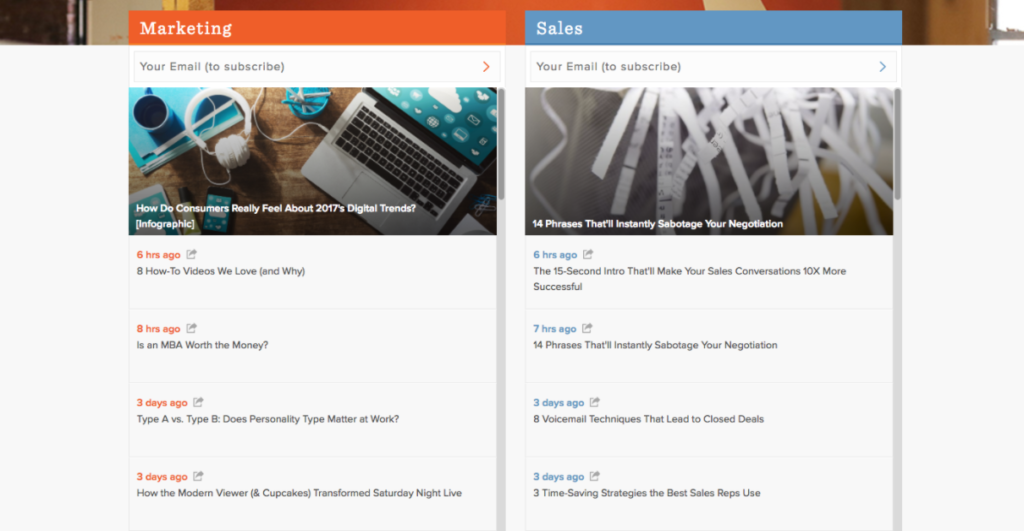
2. Stay Organized
The more organized you are with your blogging process, the more effective you’ll be. Organization breeds efficiency. Create a game plan for your blog that includes post graphics, authors, a posting schedule and promotion schedule, a list of topics with potential keyword phrases, and other essential aspects of your blogging strategy. The Moz Blog does a fantastic job organizing the front-end blog user experience which undoubtedly stems from excellent back-end organization:

3. Use Credible Sources
It’s a best practice to link to credible sources that enhance the reputation of your brand and business blog. Use names that carry significant weight in your industry to help establish your own authority by aligning your business with your audience’s perception of highly successful companies. Linking to a Forbes article is always a good idea for exactly that reason, and it also gives your a little more SEO credibility:

4. Start with an Outline
An outline is your blueprint to writing a successful blog post. It will help you follow a logical line of thinking to finish a complete series of thoughts. Too often, business blogs read like a stream of consciousness without seeming to make any sense or have a defined purpose. You can always tell when a blog post was written using an outline because there’s standardized formatting and structure:
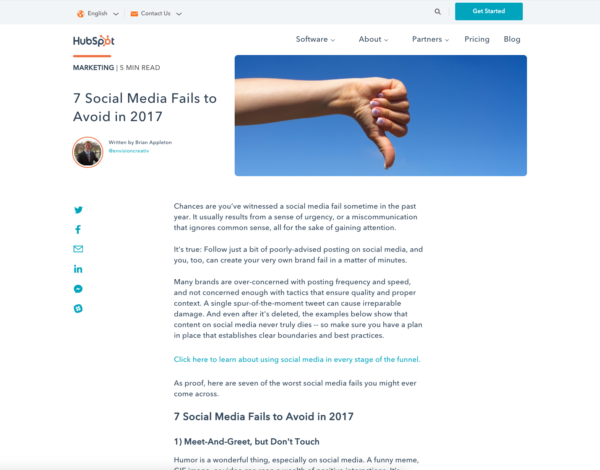
5. Keep a Running List of Blog Post Ideas
It’s a lot easier to blog consistently when you have an idea of what you want to write about. Don’t wait until the last minute to choose a topic for you business blog. Keep a running list of topics that relate to your business in a Google document, Word document, or Excel spreadsheet. Businesses that blog on a consistent basis (especially daily blogging) most certainly keep a list of blog topics close at hand. Just look at Hootsuite’s social blog homepage and the sheer number of blog posts they publish each week:
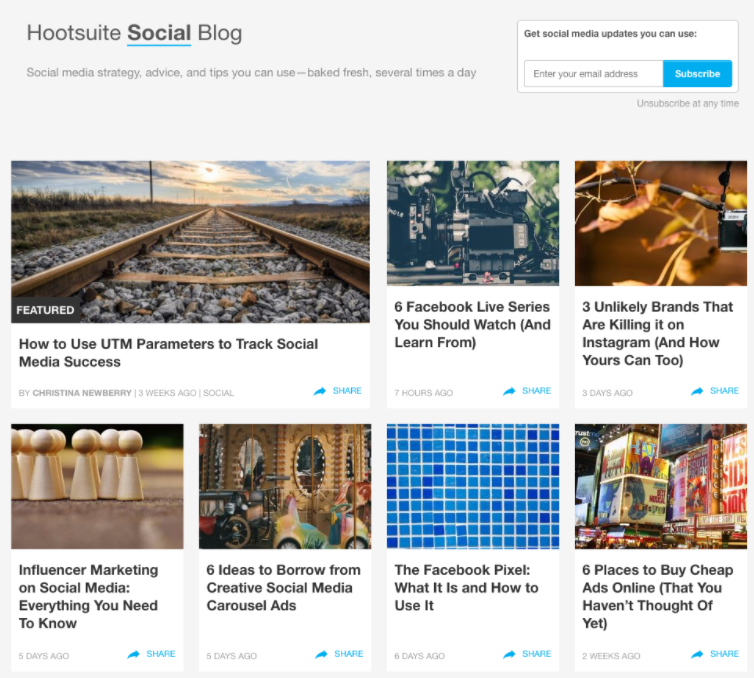
6. Use Value Keywords
Posting consistently is important, but you probably won’t get any traction without using focused keyword phrases. Using keywords allows your blog to start ranking with search engines which improves your ability to attract organic website traffic. For example, if you google “graphic design agency austin,” Envision Creative ranks on page #1 of Google search results, thanks to our focus on strategically using valuable keyword phrases:
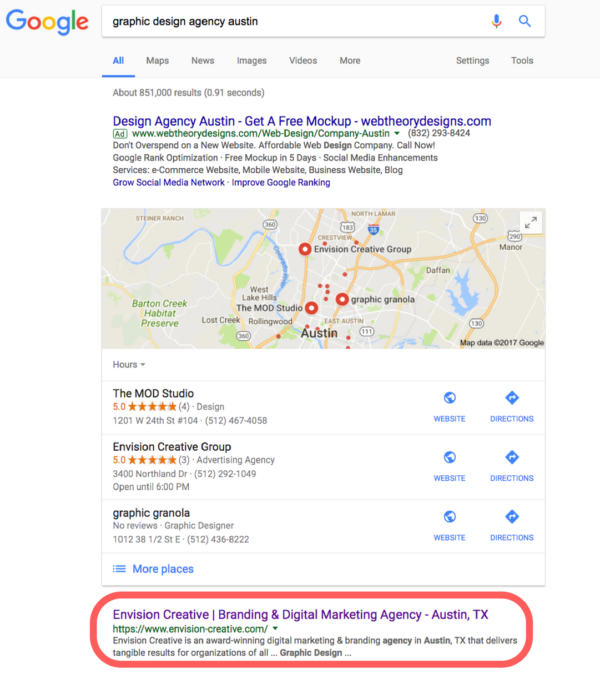
7. Check Grammar
Which sentence below looks more professional to you?
- Theres nothing your company can’t do if they focus on great strategy.
- Your company can achieve amazing results with a proven blogging strategy in place.
Chances are, you picked the second sentence because the first one is riddled with grammatical errors. Make sure your blog upholds a high standard of writing quality with stellar grammar. If not, you’ll experience a dramatic loss of credibility and respect.
8. Write About What You Know
If you run a financial firm, write about finance and investing. If you own an interior design business, talk about furniture trends, color palettes and how to stage home to sell. Stick with what you know. If you want to write about something that relates to your business, but don’t feel you have the expertise needed to create a valuable blog post you have three options:
1 .Write about something else
2. Educate yourself on the desired topic
3. Hire someone who can write from a position of knowledge
Copyblogger does a great job covering subjects directly related to content marketing and copywriting. You never fear that they’re straying away from their field of expertise:

9. Know Your Audience
Always produce blog content that your audience wants. It doesn’t matter what you want to say. If your audience isn’t interested you’re just wasting time and effort that could be better spent addressing their pain points.
Ever heard of Jon Loomer? He’s a Facebook marketing guru. Within hours of crucial Facebook updates, changes, and modifications, Loomer is already analyzing the changes and writing about how his audience can capitalize on them. His business blog is the perfect example of someone who knows their audience and caters to their needs:
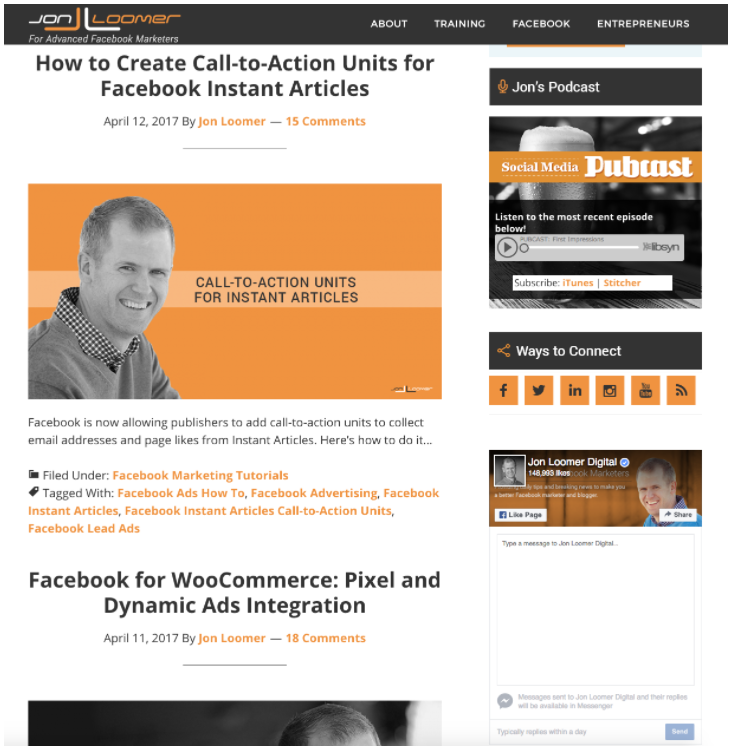
10. Avoid Self-Promotion
Self-promotion has its place in blogging, but it needs to be treated with the art of subtlety. Your visitors shouldn’t even realize you’re promoting your own blog. Instead, offer free value to your audience by educating and informing them using your company’s expertise and experience. Search Engine Land creates small profiles for all their guest bloggers that includes social media profiles and a link to their website or blog. It’s a perfectly non-promotional way to curate a generous amount of attention for their authors while positioning their site as an authority at the same time:

11. The Headline is the Most Important Part
Why do you typically open articles online? It’s probably because the headline caught your attention. Your blog needs to have engaging, compelling headlines that persuade people to click, read, and hopefully share. Tell your audience what they can expect to find without giving away the entire story.
One of our most popular blog post had a simple headline that accomplished two things: (1) it told readers that they could expect to find a massive list of 79 social media statistics, and (2) it piqued curiosity by creating a sense of urgency. Could there really be that many relevant social media statistics? See for yourself:
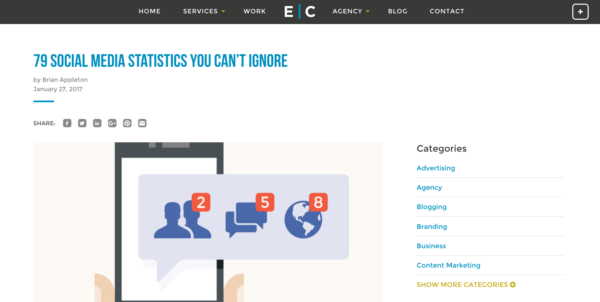
12. Don’t Be Dishonest
Dishonesty is stupid. That’s right. We said it. If you’re planning on turning your business blog into a content generation machine that doesn’t rely on facts, evidence, or educational advice, you’re setting yourself up to fail. Tell your audience exactly what you know, tell them how you know it, and tell them why it’s important. Don’t embellish and don’t exaggerate.
13. Write When You Have Enthusiasm
Trying to write a blog post when you’re feeling tired, dull, or plain depressed is a bad idea. Sometimes it’s better to postpone writing a new post until you’re inspired to write about a topic that ignites your passion. Blogging is just like 1-on-1 conversations. People can tell when the author has enjoyed the writing process and when it was a chore.
If you’re the only writer in your company take full advantage of those “enthusiastic” days to write more than one blog post. It’s always a good idea to have one of two posts stored away for rainy days. Pardot does a great job of keeping their blog content feeling energetic, fresh, and enjoyable:

14. Focus On Quality Over Quantity
Mark Shields once famously said, “There is always strength in numbers.” While it makes for a great quote, the context is often untrue, especially in business blogging. Many businesses dive head first into blogging without taking the time to evaluate the content quality their blog can maintain as the volume of posts increases. If you don’t have the time it takes to write a comprehensive, value-driven article every single week, just focus on writing one great blog post every other week rather than cranking out two or three bad ones in the same timeframe.
15. Create a Variety of Posts
Try to shake things up once in awhile. Writing a basic blog format is great, especially if the content is valuable, but sometimes your audience needs variety to stay interested. Check out these types for inspiration:
- How-to posts
- List posts
- Collection of quote posts
- Trending subject posts
- Story posts
- Review posts
- Tutorial posts
- Statistic posts
- Interview posts
16. Don’t Use Jargon
Running a professional blog means avoiding the use of Jargon. Why? Because not everyone will understand the intended context and that often leads to confusion and miscommunication (AKA annoyance). An annoyed visitor will leave your site never to return. Remember, you know your business and industry much better than the average reader of your blog. It’s your job to offer exceptional content that’s easy to digest and comprehend, while still making it worth the reader’s time. Use clear, simple language to explain difficult concepts.
Making it easy for readers to understand a difficult concept is much more impressive (and effective) than trying to impress people with terms and they won’t understand.
17. Use Examples
Images, videos, screen-shots, and audio bytes can all be great business blog tools. If you’re trying to explain a concept to your audience, examples can improve the relevancy of your blog post. Many people will understand you’re core message by simply skimming through the post when visual examples are present:
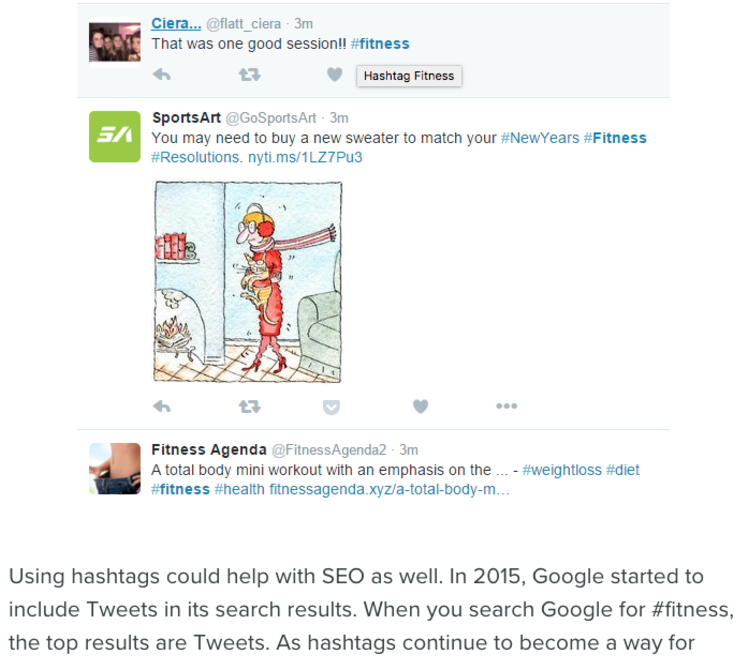
18. Leverage Social Proof
Anytime you have the opportunity to leverage the power of social proof, do it. Showing reviews, testimonials, and case studies goes a long way towards converting visitors into customers. Check out these great examples of social proof in action from HubSpot:

19. Use “Will”, not “Can”
“Do or do not. There is not try.” Words to live by from the great Jedi Master, Yoda. He might as well have said, “Will or will not. There is no can.” When you’re writing a blog, you need to convince your audience that you know what you’re talking about.
Check out the two examples below:
- Ignoring email open rates can harm the success of your campaign.
- Ignoring email open rates will harm the success of your campaign.
The second example is much more impactful because it leaves no doubt in the readers’ mind. If you use “can” in place of “will,” that leaves room for people to question your advice. There’s a reason marriage vows don’t say “I can”. “I Will” is a promise. Be decisive and reap the rewards.
20. Use Bulleted Lists
If you’re writing a blog post that’s 500-700 words, you should find a way to convey part of your article as a bulleted list to break up large text blocks. This makes it the post more user friendly and your audience will appreciate the ability to skim through your content to get to the meat of the matter.
In his blog, Neil Patel uses bulleted lists to draw the reader’s attention to the most important points that he wants to highlight:
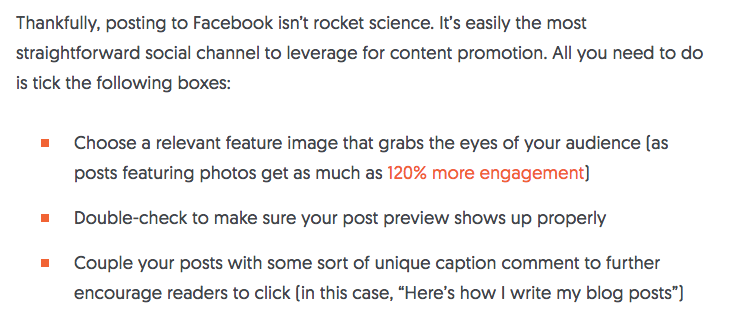
21. Quote Well-Known Experts
We’ve already done it twice in this post. You don’t have to quote Yoda on your business blog, but it’s a good idea to reinforce your arguments and points of conversation with quotes from well-known figures in your industry. It adds credibility to your content and gives the reader a familiar authority name to associate with your business.

22. Write in the Voice of Your Business
Just because you’re writing a business blog post doesn’t mean you have to be stale, boring, and use business-speak all the time. Use a conversational tone. Show some personality. Write posts the same way you and your team talk with customers. Keep it friendly and professional. Readers will appreciate your ability to infuse brand individuality into your blog content.
23. Ask Questions
When the human brain reads a question, it instantly begins to formulate an answer. Including questions in your blog posts every now and then will encourage your audience to stay engaged with your content.
Check out the way Jon Morrow uses questions to engage his audience on Smart Blogger:
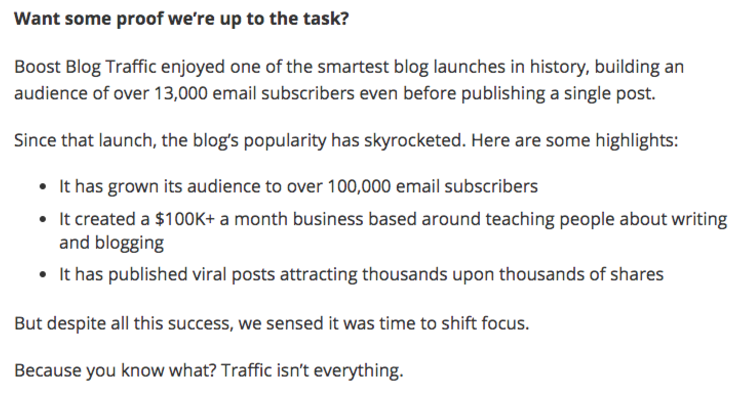
24. Include Images
Who says we have to grow up? The best part about books when we were little kids was the pictures. Not much has changed. People today still crave visual aids in the storytelling process. Your business blog doesn’t have to be overflowing with images in every single post, but you should make an effort to include at least one image per post:
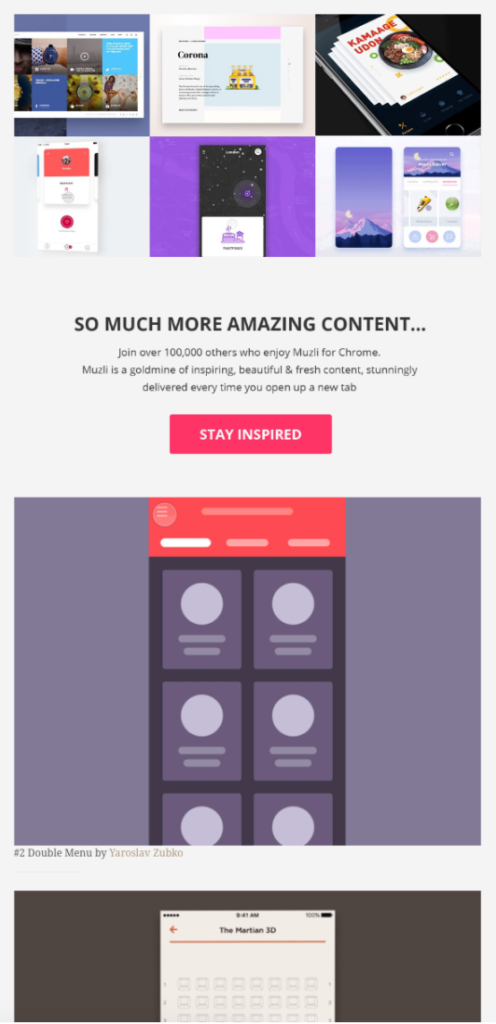
25. Write a Meta Description
Make sure your blog is as thorough on the back-side as it is on the front-end. Your meta description and title will be seen by your audience when they google your primary keyword phrase. Make sure to incorporate your keyword phrase in the meta title and meta description for every blog post:
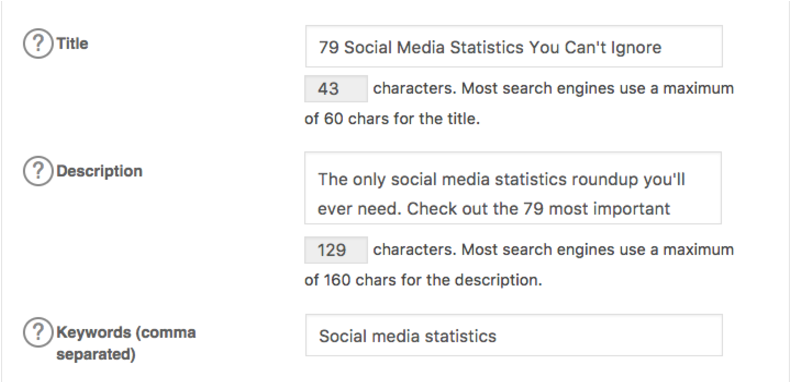
26. Be Careful with Keyword Density
It’s easy to want to overuse a keyword phrase when you find one with excellent SEO ranking possibilities. Don’t give in. Google will penalize your blog for keyword stuffing and then all parties lose. The general rule of thumb is to include your keyword and then use synonyms and related keyword phrases to enhance the relevancy of your content.
There are these little things called algorithms which search engines use to match search queries with the most accurate content results. It’s your job to write incredible content and incorporate all the elements and structure into blog posts that search algorithms favor.
27. Make Your Business Blog Shareable
Have you ever started reading an article online that was so great you had to share it with your friends on social media…only to discover that the site didn’t have sharing capability? This is an easy fix. Just find a good plugin for your blog that allows the audience to share away to their hearts content:
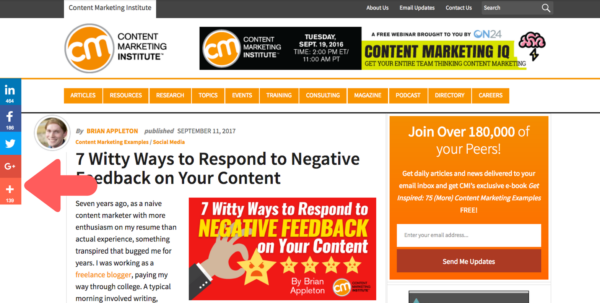
28. Share Your Blog On Social Media
Once you’ve published your blog post, it’s up to you and your team to spread the word. Use your brand’s social media channels to promote new content. If you’ve quoted a well-known figure or organization in your industry, tag them. This can increase your chances of visibility.
29. Send Your Blog Posts Via Email
If you have a regular newsletter or a list of email signups for your website, make sure they get a copy of each new blog post. This has multiple benefits: First, it positions your company as an authority in your industry, and second, it exposes your blog to a larger audience.
30. Don’t Focus on Word Count Too Much
There are numerous studies online about the importance of reaching a certain word count for each of your blog posts. Everyone has a different opinion, but the general consensus is that longer content tends to rank higher in search results. If you can write a 2,500 word blog post every week, that’s great! However, if you have trouble reaching the 1,000 word mark, don’t kill yourself trying. It’s better to have a short blog post with exceptional content than to have a 1,500 word blog post that’s filled with useless embellishments.
31. Sometimes Less is More
Here’s a pro-tip for when you’re really short on time; Create a quick checklist or “thought of the day” post that doesn’t require hours of research to create. This allows you to continue a consistent posting schedule and still deliver content that your audience finds interesting. Sure it’s simple, but it also shows consistency.
32. Be Opinionated But Not Rude
Don’t be afraid to let your audience know exactly what you’re thinking. People like strong opinions, especially when you have research to back it up. The one thing you need to avoid is being rude. Find a balance between the two and your audience will love you for it:
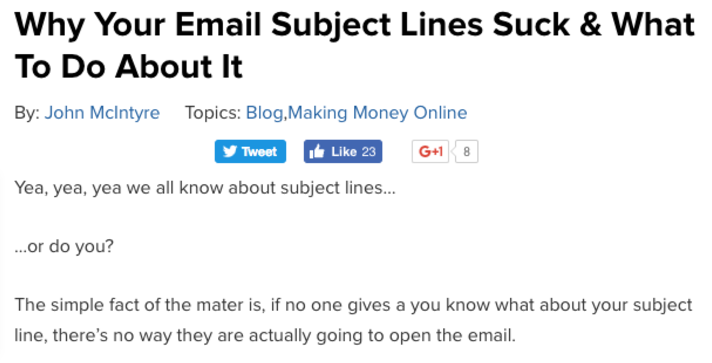
33. Triple Check Your Writing
We’re back to grammar. But this time it’s important to also check your blog posts for context and accuracy. Does your blog post make sense? Are your sources trusted?
Read through each article a few times before verifying the accuracy of your work and okaying it for publication.
34. Have Someone Else Check Your Writing
It happens to the best of us. We triple check our work. We read it out loud. We run it through a spell checker. It looks perfect. The next day a co-worker lets you know you missed a “period”, or added an extra “the”. Have someone check your post once you’re finished with it. Think of this as your quality-check before publishing.
35. Create Timely Blog Posts
Some of the best business blog posts are created as a response to recent events and news. If there’s something happening in your industry that’s receiving buzz, consider writing a blog on the subject. This is a great opportunity to reach a broader audience with your brand’s content.
There you have it. 35 lessons we’ve learned that you can use to benefit the results of your very own business blog.
-FINAL(01-00)-White&Blue-01.svg)





